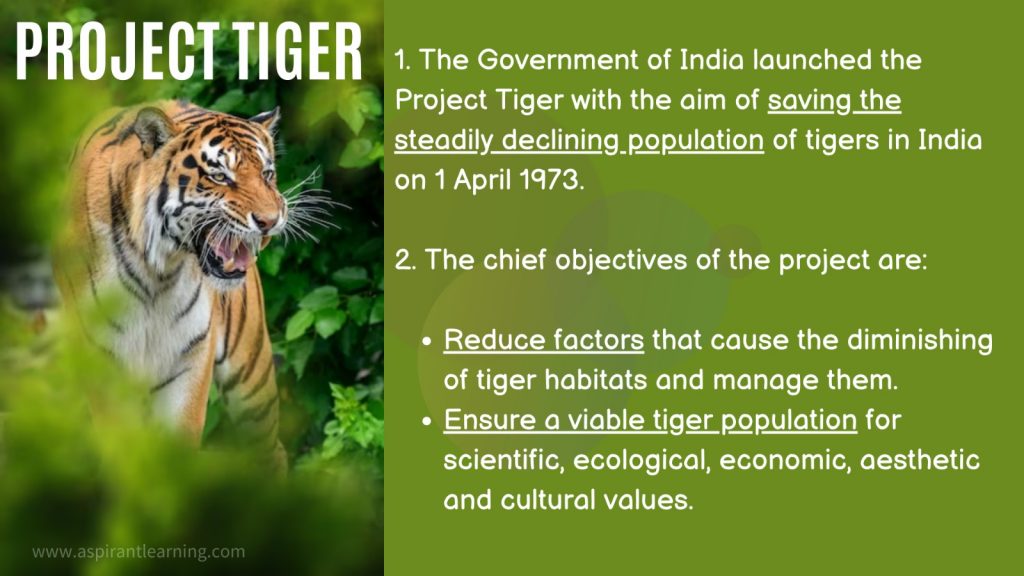News highlights:
- According to estimates from the latest tiger census, India has at least 3,167 tigers.
- There were 2,967 tigers recorded in 2018 and 2,226 in 2014.
- The tiger population numbers were made public by Prime Minister at an event to mark the International Big Cat Alliance conference as well as the 50th anniversary of Project Tiger.

International Big Cat Alliance (IBCA):
- About:
- The Government of India has proposed to set up the International Big Cat Alliance.
- IBCA is a proposed mega-global alliance that will work toward the protection and conservation of the seven major big cats — tiger, lion, leopard, snow leopard, puma, jaguar, and cheetah.
- The Purpose of the alliance is to provide a platform for the dissemination of information on benchmarked practices, capacity building, resources repository, research and development, awareness creation, etc., on the protection and conservation of big cats.
- According to a proposed timeline, the alliance is expected to be launched next month in India.
- According to sources in the Environment Ministry, the alliance was inspired by the arrival of cheetahs last year from Namibia.
- IBCA’s major activities include “advocacy, partnership, knowledge e-portal, capacity building, eco-tourism, partnerships between expert groups and finance tapping”.
- Membership:
- Membership to the alliance will be open to 97 “range” countries, which contain interested nations, international organisations, etc.
- These are the countries which contain the natural habitat of these big cats.
- Composition:
- The IBCA’s governance structure will comprise a General Assembly consisting of all member countries, a council of at least seven but not more than 15 member countries elected by the General Assembly for a term of 5 years, and A Secretariat.
- Upon the recommendation of the Council, the General Assembly will appoint the IBCA Secretary General for a specific term.
- Funding:
- For the first five years, IBCA will be supported by India’s ‘total grant assistance’ of $100 million.
- After this, the alliance is expected to sustain itself through membership fees and contributions from bilateral and multilateral institutions and the private sector.
The Seven Big Cats:
- Tiger (Panthera Tigris):
- Tigers are listed as “Endangered” by the International Union for the Conservation of Nature (IUCN) Red List of Threatened Species.
- The tiger is the largest of all wild cats and the most ancient of the Panthera.
- The tiger is primarily a forest animal that can be found from the Siberian taiga to the Sunderban Delta.
- It is the national Animal of India, Malaysia, Bangladesh, and South Korea.
- Lion (Panthera Leo)
- In the International Union for the Conservation of Nature (IUCN) Red List of Threatened Species, Lion is enlisted as “Vulnerable”.
- Lion is native to Africa and Asia. They live in groups called “Pride”, and they usually prefer open forests.
- The lions are among the most recognised animal symbols, from Ashokan Pillars to the entrance of Buckingham Palace.
- Jaguar (Panthera Onca)
- In the International Union for the Conservation of Nature (IUCN) Red List of Threatened Species, Jaguar is enlisted as “Near Threatened”.
- Jaguar is the largest cat in America and has the strongest bite.
- Melanistic (Black) jaguars are the most common ones and are often called Black Panthers.
- Cheetah(Genus Acinonyx)
- It is a unique genus within the cat family with only one living species which is Cheetah.
- Cheetahs are listed as “Vulnerable” by the IUCN Red List of Threatened Species.
- A cheetah is the fastest land mammal, and its grip helps it to accelerate faster than a sports car (0-100 km/hr in 3 sec.)
- Leopard (Panther Pardus)
- Leopard is similar in appearance to the jaguar. They are the most adaptable of all as they can survive in diverse habitats at all altitudes across Africa and Asia.
- Like Black Jaguars, melanistic leopards are called black panthers.
- Leopards are listed as “Vulnerable” by the IUCN Red List of Threatened Species.
- Snow Leopard (Panthera Uncia)
- Snow leopards live above the snow line in Central and South Asia.
- Snow Leopards cannot roar and has the longest tail of all.
- It is a state animal of Ladakh and Himachal.
- In the International Union for the Conservation of Nature (IUCN) Red List of Threatened Species, Snow Leopards are enlisted as “Vulnerable”.
- Genus Puma
- Genus Puma is closely related to domestic cats, and this genus has only one extant species known as Cougar.
- Cougar is the second largest cat in America, and the jaguar is the largest and has a range from the Canadian Yukon to the southern Andes.
- It has the status of “Least Concern” on the IUCN Red List.
Pic Courtesy: Freepik
Content Source: The Hindu



